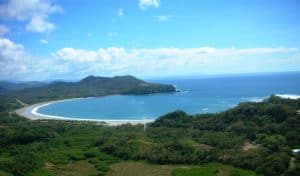Situated along the Pacific Coast of Costa Rica’s Guanacaste Province, Puerto Carrillo is a jewel among Costa Rica’s Pacific beaches. This beach it’s a 2 hour drive from Roma del mar.

The beautiful white sand beach has small waves most of the time, and is popular with swimmers and families with kids. Playa Carrillo is never crowded, and it offers nice picnic areas right on the beach. Your car will be within easy reach, wherever you decide to spend your day in the sand. Carrillo also offers beautiful and secluded small beaches near by, El Roble is a rocky beach with its own waterfall and tide pools. Playa El Sur, beautiful medium size beach surrounded by palm trees (only accessible by boat). Playa Samara, 4 km to the north, is a much larger beach. with waves generally near knee to waist high, and is a popular place for beginning surfers and families.
Sámara has long been a favorite vacation spot for both Costa Ricans and foreigners. Sámara is a much larger beach than Carrillo. with waves generally near knee to waist high, and is a popular place for beginning surfers and families.
PICTURE: By Jackiemora01 – Own work, CC BY-SA 3.0, https://commons.wikimedia.org/w/index.php?curid=17349679
The Karen Mogensen Nature Reserve is located in the mountains of the Nicoya Peninsula, at an altitude between 100 and 700 meters. Its 900 hectares form part of Costa Rica’s biological corridor. This protected zone hosts large areas of primary forest with giant trees, lushly adorned with mosses, vines and many orchids. Due to a reforestation program the dry tropical forest is now in transition to a humid forest and boasts a spectacular array of flora and fauna, many of which are in danger of extinction. Rare animals like ocelots, jaguars, pumas and otters make the forest their home and countless birds and butterflies can be seen.
The Karen Mogensen Reserve is off the beaten tourist path. To fully explore the reserve and its attractions you can have a great hike or even stay overnight in the reserve’s guest house up in the hills. Cerro Escondido Lodge is surrounded by primary forest and there are several hiking trails leading through the lush vegetation. Many rivers have their source in the reserve and the waterfalls and creeks are great for bathing while watching wildlife and nature.
The town features a mix of local residents as well as foreign backpackers and eco-tourists who come for the beaches, rivers, and scenic waterfalls that surround the village. The nearby Cabo Blanco Nature Reserve draws a large number of visitors to the area. This amazing beach is an hour and a half ride from Roma del Mar.
PICTURE: By Jonathan Greeley – Own work, CC BY-SA 3.0, https://commons.wikimedia.org/w/index.php?curid=17711947

“La Fortuna” is Spanish for “The Fortune”, and aptly named due its ample supply of tourist attractions and extremely fertile lands. Although there is a common myth that the town got its name due to its sparing from the Arenal Volcano‘s eruptions, the town actually got its name before the latest eruption cycle and was named for the fertile lands (“The Fortune”) where it is located.
Arenal is often cited by scientists as being in the top 10 or top 20 of the world’s most active volcanoes. La Fortuna is less than 10 kilometres (6 mi) from the 5,480 feet (1,670 m) peak of Arenal and less than 20 kilometres (12 mi) from the Arenal Volcano National Park entrance, which is west of the peak, whereas La Fortuna is east of the peak.
In addition to the volcanoes, La Fortuna has tourist attractions such as the 70 metres (230 ft) La Catarata de la Fortuna waterfall, several resorts with natural hot springs temperate enough to bathe in, other day spa services, and day-trips that involve horseback riding, whitewater rafting, hanging bridges, a “sky tram,” zip-lines, mountain biking, kayaking, stand-up paddleboards, ATV or dirt bike rentals, “butterfly farms,” the Venado Cavern tours, bungee jumping, Laguna Cedeno, El Salto Swimming Hole, and canyoneering.

